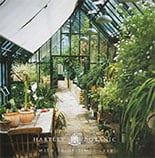
I’ve been a gardener since childhood. In England, as I was growing up, I tended the family garden while my dad traveled frequently for work. After I moved to the US, my wife and I bought land in Rhode Island. A Victorian-era house had previously been on the property, but it had long ago been taken down and the property had grown over. Nothing remained of the former landscaping except a very tall and unruly privet hedge surrounding the property that, pictures show, had been planted before 1942. During the first gardening season after building a new house, I tried planting crops in what was largely the subsoil from the building project. All that I ended up with was a lot of okra. Never having grown okra before, I had no idea what to do with it. So I made a terrible gumbo, then binned it.

Each year after this first one, I worked on building the garden soil. I backbreakingly screened out all the rocks, and added large amounts of manure, seaweed, compost, leaves, and anything else organic. Over time, the soil became far richer in nutrients, with a greatly improved structure. Here in New England, though, soil also keeps “growing” rocks as glacial till that’s not far beneath the surface continually rises upward. Rock removal is a constant task, as is rock wall building. My harvests significantly increased not just after improving the soil but also after I built some raised beds. These beds helped me to organize my crops as well. I devoted one large bed just to asparagus. Even though this bed was first planted nearly 30 years ago, it’s still producing spears today. Next to my asparagus bed is one devoted half to rhubarb and half artichokes. All three of these crops are perennials, so these two beds are permanently planted. Every other bed in my garden is used for annual crops that I rotate yearly.

Not long after my first raised beds were constructed, I built a wood-framed 10’ x 30’ heated greenhouse abutting my design studio. Although at first this greenhouse seemed far larger than I needed, there’s now barely space for even one more plant. During winter, I initially used a propane heater in this greenhouse, but the constant sight of it glowing on cold winter nights made me fear I might burn my studio down. So I eventually switched to an electric heating system. It’s more expensive to use but offers greater peace of mind! This heated greenhouse allows me to grow citrus trees, orchids, mandevilla, agapanthus, avocado, and other tropical and semi-tropical plants in a climate where winter temperatures can drop far below freezing. When this heated greenhouse was filled, I built a second unheated one, also wood-framed and using glass that came at no cost from the local transfer station. In it, I grow peas, beans, lettuce, herbs, and strawberries, enjoying yields up to a month before my outdoor beds produce anything. One factor that slows the development of my outdoor crops is the cold wind directly off the ocean in spring. To help overcome this problem, I’ve recently installed a hoop house over a pair of 40’ long, raised beds in the hope of keeping the cold spring winds off the plants and enabling earlier harvests.

Another part of my garden’s evolution has involved starting seeds under lights in my basement during winter and then transplanting them to my unheated greenhouse for a month to six weeks before moving them to their final destination in an outdoor garden bed. Given all this movement, I sometimes wonder if my plants should somehow come equipped with wheels. But to me, successfully tending plants in their various stages of development is part of the fun of gardening and one of the secrets to getting large, early yields. You may wonder what I do with all the produce that I harvest. That’s a topic for a future blog!


